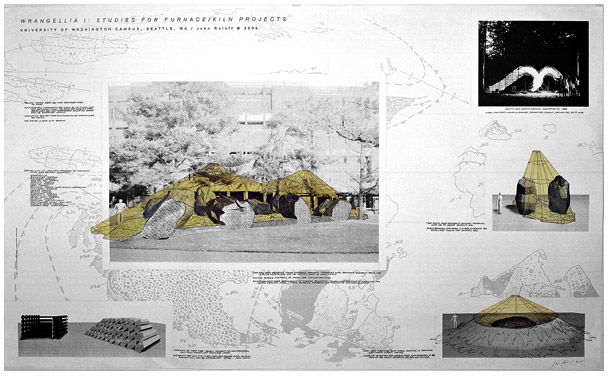SELECTED
TEXT PANELS: WRANGELLIA I - left to right.
Yellow
tinted areas are fired areas/heat zones or flues. Kiln/furnaces components
are shown by yellow tint and structural lines; they are made of a steel
framework and high-temperature insulating blanket
or refractory cement. Insulating blanket kiln/furnaces are removed after
the firing. Firing is done by propane.
Two-row rock grouping from different geologic terranes with seafloor
sediment from the Juan de Fuca plate of the Pacific Coast of Washington.
Outside facing surfaces of base rocks are cut and polished. Kiln/furnace’s
form reminiscent of Cascade Mountains. Unpolished portions of rocks and
the space between them is fired, altering rocks
and fusing the seafloor sediment.
Partial List of Terranes of Washington State and British Columbia:
Wrangellia
Alexander Terrane
Turtleback Terrane
Deadman Bay Terrane
Garrison Terrane
Decatur Terrane
Haro Terrane
Methow Terrane (North and South subterranes)
Chilliwack Terrane
Vedder Terrane
Easton Terrane
Hozameen Terrane
Quesnellia Terrane
Cache Creek Terrane
Olympic Terrane
Okanogan Subcontinent
North Cascade Micro-continent
Insular Superterrane
Intermontane Superterrane
Intrinsic or inert
fire: basalt columns cut and polished, cast iron streetlight poles
and lamps. Elements are not site-fired (prefired during their original
formation), may be distributed differently than shown.
Cast iron “meteor” with
fossil surface in seafloor sediment impact crater. Interior of crater
and meteor fired, kiln removed at the peak of the firing revealing
red-hot meteor and sediment.
Two rocks from
different geologic terranes with Mt. St. Helens volcanic ash. Space
between the rocks is fired altering the rocks and fusing the volcanic
ash.
|
SELECTED
TEXT PANELS: WRANGELLIA II - left to right.
Standing cast iron
octopus with rocks from Wrangellia and Alexander Terranes and seafloor
sediment. Outside facing surfaces of base rocks are cut and polished..
All elements
fired to high temperature except for polished areas, rocks are altered
by heat, cast iron is allowed to rust over time.
Cast iron standing octopus with structure developed from windows
of UW’s
Gothic church. Cast Iron, cast refractory cement. Octopus is allowed
to rust over time, interior of structure altered by heat.
Horizontal cast iron octopus as an intrusion into a stratigraphic
sequence (sill).
Sedimentary rocks (ophiolitic/turbidite sandstone) or similar rocks.
Octopus is allowed to rust over time, interior of structure altered
by heat.
Drifting (cast
iron) octopus with coating of seafloor sediment from the Juan de
Fuca Plate. 3
cast iron flues connected underground to kiln/furnace
forming a downdraft system for firing.
Construction sequence:
Cast iron elements are installed with underground flue connections.
Seafloor sediment thickly placed over entire octopus.
Sediment partially eroded from octopus by natural rain or high pressure hose
revealing 40 - 60%of octopus.
Kiln/furnace placed around octopus/sediment assemblage and fired.
Kiln/furnace removed.Octopus will rust which further alters fired sediment by
leaching and staining; flues and underground system left standing, allowed to
rust. |

